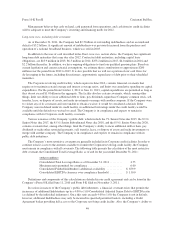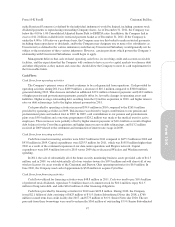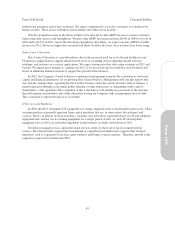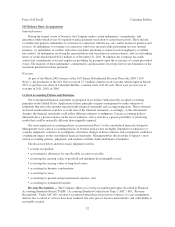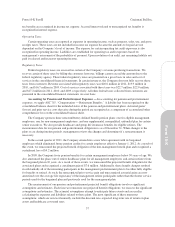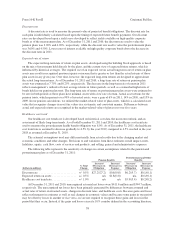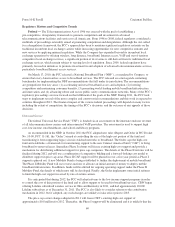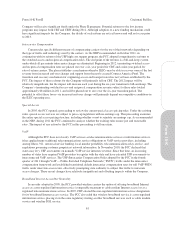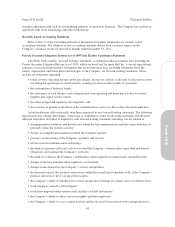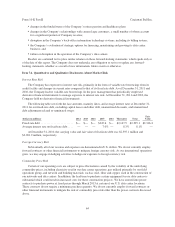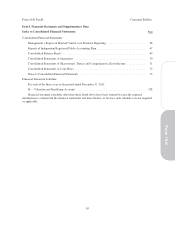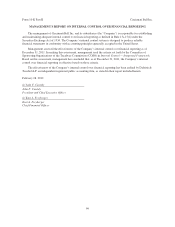Cincinnati Bell 2011 Annual Report Download - page 174
Download and view the complete annual report
Please find page 174 of the 2011 Cincinnati Bell annual report below. You can navigate through the pages in the report by either clicking on the pages listed below, or by using the keyword search tool below to find specific information within the annual report.estimated at zero due to the absence of a resale market for these assets. No asset impairments were recorded in
2010 or 2009.
Accounting for Business Combinations — In accounting for business combinations, we follow ASC 805,
“Business Combinations,” which requires the recording of net assets of acquired businesses at fair value. In
developing estimates of fair value of acquired assets and assumed liabilities, management analyzes a variety of
factors including market data, estimated future cash flows of the acquired operations, industry growth rates,
current replacement cost for fixed assets, and market rate assumptions for contractual obligations. Such a
valuation requires significant estimates and assumptions, especially with respect to the intangible assets.
Transaction costs associated with acquisitions are expensed as incurred.
In determining the fair value of the assets acquired with the purchase of CyrusOne, management utilized
several valuation methods:
•Excess earnings method: This method was used to determine the fair value of the CyrusOne customer
relationships. This method estimates the present value of future cash flows attributable to the customer
base and requires estimates of the expected future earnings and remaining useful lives of the customer
relationships.
•Cost method: This method was used to determine the fair value of property, plant and equipment. This
method indicates value based on the amount that currently would be required to replace the service
capacity of the asset and considers the cost of a buyer to acquire or construct a substitute asset of
comparable utility, adjusted for deterioration and obsolescence.
•Relief-from-royalty: This method, used to determine the fair value of the CyrusOne trademark, estimates
the present value of royalty expense that could be avoided as a result of owning the respective asset or
technology.
In 2011, we finalized the CyrusOne purchase price allocation. No significant changes were made in 2011 to
the estimates or assumptions applied in the preliminary purchase price allocation.
Accounting for Taxes
Income Taxes
The Company and its subsidiaries file income tax returns in the U.S. federal jurisdiction as well as various
foreign, state and local jurisdictions. The Company’s previous tax filings are subject to normal reviews by
regulatory agencies until the related statute of limitations expires. With a few exceptions, the Company is no
longer subject to U.S. federal, state or local examinations for years prior to 2008. In 2011, the Internal Revenue
Service completed an examination of the Company’s U.S. federal income tax returns for 2008 and 2009.
The Company has net operating loss carryforwards at the federal, state and local levels. Federal tax loss
carryforwards are available to offset taxable income in current and future periods. The majority of these tax loss
carryforwards will expire between 2021 and 2023 and are not currently limited under U.S. tax laws. The ultimate
realization of the deferred income tax assets depends upon our ability to generate future taxable income during
the periods in which basis differences and other deductions become deductible and prior to the expiration of the
net operating loss carryforwards. Based on current income levels and anticipated future reversal of existing
temporary differences, management expects to fully utilize its federal net operating loss carryforwards within
their expiration periods. However, realization of certain state and local net operating losses, as well as other
deferred tax assets, is not certain. A valuation allowance of $58.4 million and $60.0 million has been recognized
as of December 31, 2011 and 2010, respectively. In 2011, we reduced valuation allowances by $1.6 million
primarily based on the expected future utilization of certain state deferred tax assets.
As of December 31, 2011 and 2010, the liability for unrecognized tax benefits was $21.8 million and $20.5
million, respectively. As of December 31, 2011, the amount of unrecognized tax benefits that, if recognized,
would affect the effective tax rate is $21.5 million. Management does not currently anticipate that the amount of
unrecognized tax benefits will change significantly over the next year. Accrued penalties related to unrecognized
56
Form 10-K Part II Cincinnati Bell Inc.


